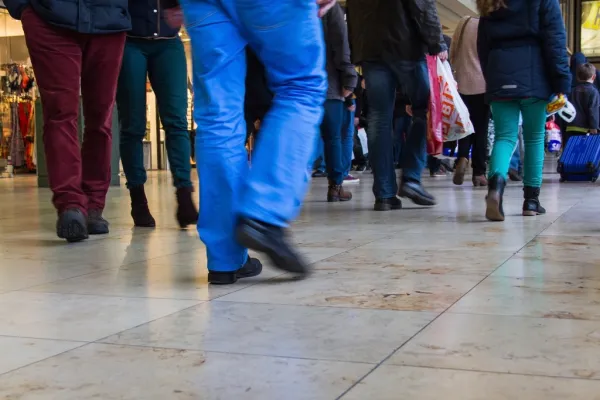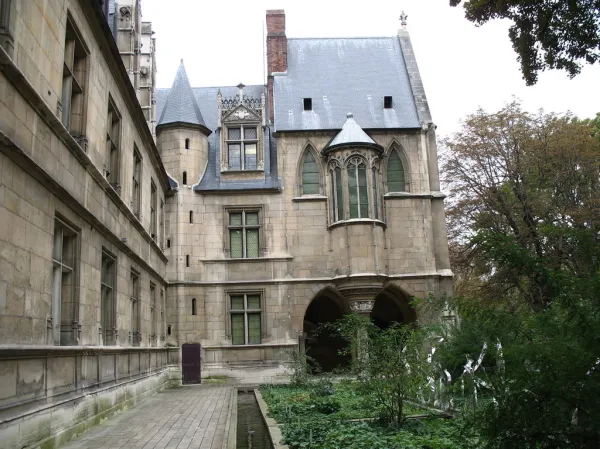 was day-dreaming about a day in Paris. American friends say, “Oh, I’ve been to the museums. I’m going out of town.” Well, let me get out my snobby pince-nez and say, “Well!” How many times do I go stand at the Musée d’Orsay, a former train station, so very cool in that regard, and look out through the big clock onto the world below? You know that adage, (dumb). Think globally, act locally. People! Think locally, act locally.
was day-dreaming about a day in Paris. American friends say, “Oh, I’ve been to the museums. I’m going out of town.” Well, let me get out my snobby pince-nez and say, “Well!” How many times do I go stand at the Musée d’Orsay, a former train station, so very cool in that regard, and look out through the big clock onto the world below? You know that adage, (dumb). Think globally, act locally. People! Think locally, act locally.
Here’s a day. A day in Paris. Medieval Paris.
Tip: Make reservations at the Cluny, at the Sainte Chapelle and at St Julien le Pauvre.
Tip2: These are in walking distance from each other. I give you the walking time.
FONTAINE ST MICHEL
I’d start out at the Fontaine St Michel in the 5th. The archangel is black against a gigantic background. It’s an easy monument to enjoy. And it gets you right into the thick of things. The 5th arrondissement is known as the Latin quarter, where the students and the clergy who taught them spoke Latin. After admiring the fountain, the next stop is to become un flaneur and find a café that looks appealing. Now, un flaneur is somebody who isn’t afraid to wander. “How about we wander over here?” This is a very important stage of your visit. Tourists have a list to check off. We have a day to enjoy.
READER: We’ve only just started our day. We can’t go to a café. We have places to go.
ME: Café.

MUSEE de CLUNY
7 min walk from the fountain
This museum is also in the 5th. It is also known as the National Museum of the Middle Ages (Musée national du moyen age). In the year 1331 it was the Parisian mansion of the Abbey of Cluny, an order of Benedictine monks. It’s considered one of the oldest private residences in Paris. (I’ve seen it called a townhouse, even a pied-à-terre for the young abbot, to increase his status.)

READER: A townhouse for the monks?
ME: Yes, Wikipedia hurries over that part to get to the Thermal baths.
Parisinsidersguide says this:
“This gem of a Latin Quarter museum [emphasis theirs] straddles the ruins of the second-century Roman baths and also manages to house one of the world’s finest collections of French medieval art, including the famous Lady and the Unicorn tapestries.” And I put it this way, Roman thermal baths were discovered in the basement, and on the main floor are the most exquisite unicorn tapestries, which are intricate tapestries dedicated to each of the five senses. Stained glass and other treasures abound, including ancient crowns of the Visigoths, the barbarians who sacked Rome in 410. I mean, crowns?
JARDIN DE LUXENBOURG
10 minute walk from the Cluny
Now it’s time for the outdoors! Time to clear your head from so much fascinating history. I mean, where were you in 1331 when our young abbot was showing off? People say this is the most beautiful garden in Paris. In 1612, Marie de’ Medici commissioned this to be reminiscent of her childhood palace in Florence. Remember that you have practiced being un flaneur. You get to do this again in the same day. Gardens, fountains, a large bassin (basin) where model sailboats float free, sculptures. Ah, it is a beautiful life.

READER: They say Marie de’ Medici (1575-1642) was bored living in the Louvre.
ME: It is okay to be angry at capitalism, says Bernie Sanders.
READER: When did capitalism start?
ME: Some say it began in Italy (see de’Medici); others say it began as a French word to describe the British.
READER: I happen to know that the first corporation was the Dutch East India Company. They had their own militia and their own currency. What? Why are you looking at me?
ME: Back to Paris.
PANTHEON
3 min walk from the gardens
This beautiful building, modeled on the Pantheon in Rome, and built in 1758, sits atop the hill St Geneviève, who was the patron saint of Paris, (the saint, not the hill). Many French luminaries are buried here. Women were only relatively recently granted the privilege of resting here for eternity: The remains of Marie Curie, who died in 1934, along with her husband’s remains, were removed here in 1995; the American singer and resistance figure, Josephine Baker in 2021, and the remarkable government minister and Holocaust survivor, Simone Veil in 2018, among others. (Six women.) Men? You’re on your own for counting.

PLACE DE LA SORBONNE AND FOOD
3 min walk from the Panthéon
A beautiful square right next to the Sorbonne University
Restaurant : L’ecritoire ; Address: 3 place de la Sorbonne
The Sorbonne was established in 1257 by Robert Sorbon, as one of the initial universities in Europe. Madame Curie and her husband were on the faculty of science there. Many prize winners have emerged from these glorious halls.

OUR LOVELY NOTRE DAME DE PARIS
11 min walk from the Place
This damaged cathedral is scheduled to reopen in December of 2024. Even if your tour is restricted to the grounds, it is a lovely church to visit. Stand in the parvis (the large square in front) and study the façade with guide book to inform you. A Frenchwoman recently called Paris a book of history.
SAINTE CHAPELLE
6 min walk from Notre Dame
Precious vestige of the royal palace, the Sainte-Chapelle was built in the middle of the 13th century by Louis IX, future Saint Louis, to house the most prestigious relic of the Passion of Christ: the Crown of Thorns and a fragment of the True Cross.

READER: People probably won’t click on the link to the crown of thorns.
ME: Ah, but they’ll miss the pretty stained-glass windows. There are 15 bays of stained-glass, 15 meters high, with 1113 stained-glass panels!
NOW YOU HAVE SOME CHOICES TO MAKE
//SHAKESPEARE AND COMPANY
Very few minutes nearby
This iconic bookstore is a must see.
//MARCHE AUX FLEURS
1 minute walk
At the very heart of Ile de la Cité, the flower market is an unusual treat. (Birds on Sunday.)
//SEINE CRUISE
Maybe this is more your cup of tea. Come back and make an afternoon of it.
ST JULIEN LE PAUVRE
near Shakespeare and Co
In the evening, find a concert held at Saint-Julien-le-Pauvre. One of the oldest churches in Paris, it “replaced a 6th-century oratory dedicated to Saint Julien de Broude, which was part of a Merovingian hospice which sheltered pilgrims without funds,” so says Uncle Wiki. Candlelight piano concert transforms the church and you!

GODOT
In 1981, Herbert Mitgang of the venerable NY Times has this to say about an encounter with Samuel Beckett: “Beckett says that he began to write in French because he wanted to get away from his mother tongue; writing in English somehow made it come too easy. The French language offered greater clarity and forced him to think more fundamentally, to write with greater economy.” In short, Beckett loved the French language, and in fact composed “Waiting for Godot” first in French, before he translated it himself into English, and he loved France. I wonder if he’s referring at least in part to himself in the words he gives Pozzo toward the end of Act I. Pozzo, the interloper who holds Lucky by a rope, says goodbye to Estragon and Vladimir. They say adieu and thank you and more goodbyes, including “yes, yes” and “no, no.” Pozzo says, “I don’t seem to be able …….. (long hesitation) …………… to depart.” Estragon responds, “Such is life.” Immediately after Estragon tells Pozzo he’s going the wrong way, we see is a lovely instance of Beckett’s ambiguity. The sophistication of Paris gives way to a country scene in the play, it’s true. And yet the sophistication of the language, the clarity and the thinking fundamentally, well, that stays French. In short, spend a day in Paris!
As usual, learned something new from you. I never knew “writing in English somehow made it come too easy. The French language offered greater clarity and forced him to think more fundamentally, to write with greater economy.”
RESPECT !